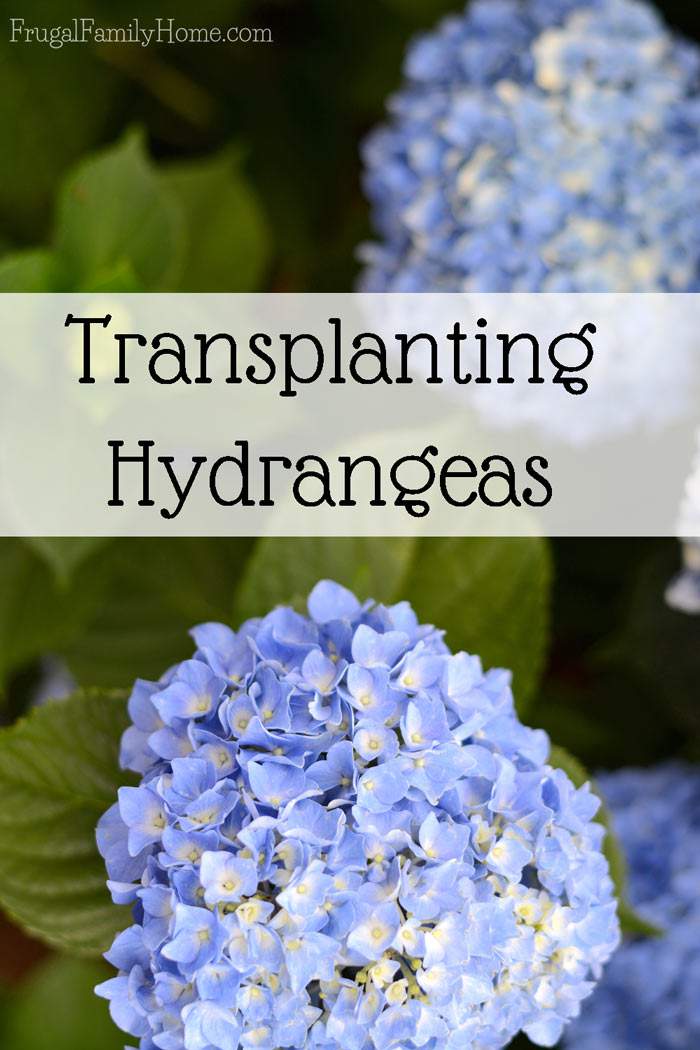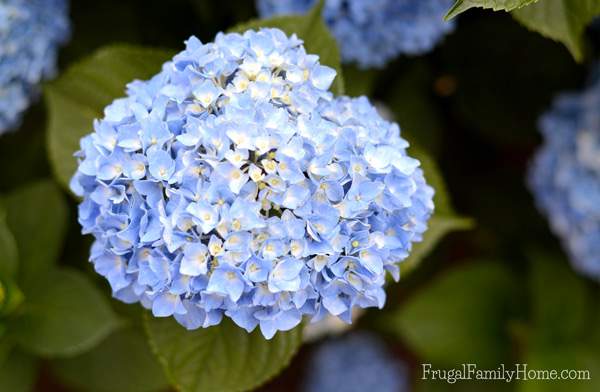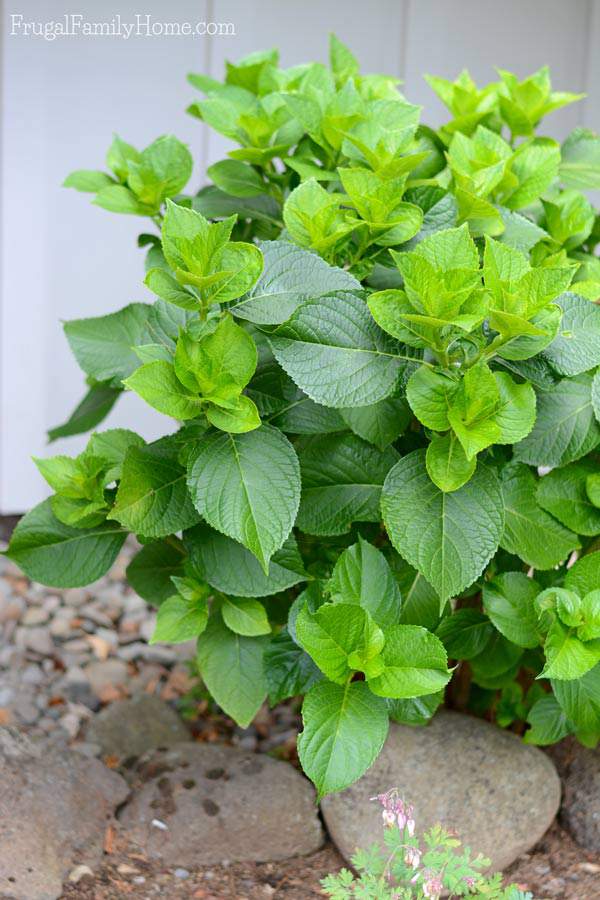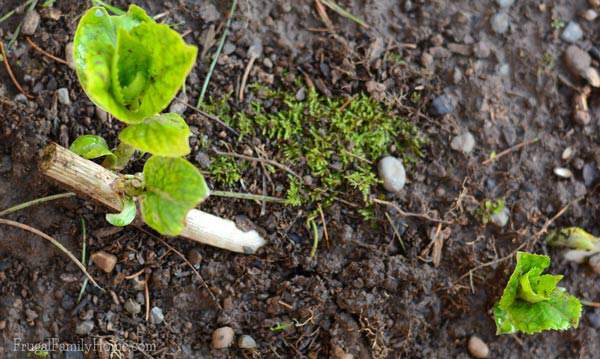Transplanting Hydrangea, How One Grew into Three

I love hydrangeas. They have such beautiful huge flower clusters and the leaves are very pretty too. But did you know when you are transplanting hydrangea you might end up with more? We started out with one huge hydrangea and ended up with three plants in the end.
When we purchased our home there was a huge hydrangea planted under the overhang of the upper floor. The people who owned the house before us hadn’t done much yard maintenance in quite a while and everything was overgrown. The rhododendrons actually covered the second story windows. The yard was quite a mess.
The hydrangea under the second story overhang of the house was so huge for the spot they had planted it in, my husband and myself decided it needed to be moved. We relocated it over to where two huge fir trees had been. We had to take the fir trees out because they were planted so close to the foundation of the house, we thought in time, it might crack the foundation. So they needed to go.
Transplanting Hydrangea, the first time
While digging up the hydrangea, we tried to be sure to remove the hole root ball and expanding roots. It was quite a job and a big hole once we were done. We thought we had gotten all of the roots. We transplanted the hydrangea and it seemed to be happy in it’s new spot.
But we must have missed a root and the hydrangea started to regrow, where we had moved it from. Because it was a much smaller plant, we let it there to grow. We decided to leave the new hydrangea where it was under the second story overhang. After all it was determined to live there and the newly grown plant was much smaller. With regular trimming we have managed to keep it small.
Transplanting Hydrangea, the second time
Fast forward a few years to last spring while I was doing my fall leaf clean up and yard maintenance, my husband found that a branch of the big transplanted hydrangea had rooted in under the leaves that had fallen and built up at the base of the plant.
We cut the branch off from the main plant and pulled it up. At first we were just going to compost it, but then we thought we would try to replant it in another area. After all this hydrangea had proven to be pretty hardy in the past and the worst that would happen is it wouldn’t grow.
We planted the rooted branch under our maple tree and there it sat dormant all winter. I wasn’t sure it would start to grow in the spring but to my surprise, it started to grow leaves. Then a couple of weeks ago it started to bloom.
It’s a very tiny little hydrangea with two big flowers on it. I assumed the blooms would be blue just like the original plant in front yard, but it turned out to be a beautiful lavender color instead. I believe the soil under the maple tree must be a little more alkaline or that area must have less aluminum in the soil. I think that is what makes the hydrangea change the color of the blooms.
It’s hard to believe that from one hydrangea plant we have now have three, the two extra we never really intended to have but they are a lovely addition to our garden. I love it when you can get another plant for free just by dividing it or transplanting a branch like what happened this past year.
Have you ever tried transplanting hydrangea and ended up with more than the original plant?
Click here to see all of my gardening posts.
Other Gardening Posts You’ll Love,
Ways to Save on Spring Flowers
Garden Guide for Growing Basil
How to Save Seeds for Next Year Planting
Get the Companion Plants List
When you join the gardening email list, you'll not only get gardening tips sent to your inbox, you'll also get the companion plants list too.






Hydrangea plants are so beautiful. My mother-in-law loves plants and this looks just like the plant we gave her for either Mother’s Day or her birthday one year. 🙂
They are really beautiful. I wish they had a scent too. But the beauty of them is enough. 🙂
From one to three, what a great deal 🙂 I love hydrangeas! We have one in the front of the house that is growing huge healthy leaves but has not flowered. Do you have any suggestions that we can try to get it to flower?
Tina, I’ve never had that problem before. Maybe it’s too little sun or possibly the type of hydrangea you have. I remember an episode of This Old House addressing a hydrangea that won’t bloom. Here’s the link, hopefully you will find something that will work for your hydrangea and get it blooming.
Thanks so much for the link Shelly I will check it out 🙂
My mother had gotten a beautiful hydrangea plant as a gift in a basket. We just planted it in a small spot along our sidewalk. It took 2 yrs before it decided to grow flowers. Now I want to transplant it to a larger location. I know nothing about the care of them. Do I need to treat the soil so that they will bloom next year?
Janet, When we’ve transplanted our hydrangea plants, we dug them up trying to get all the root ball and roots extending. We dug around the drip line. The drip line is how far the plants leaves reach away from the main stalk of the plant. The main thing to remember about hydrangea is they are a shade plant. They need to be at least in part shade. Be sure to plant them where they will get shade for part of most of the day.
When you are planting the dug up hydrangea to its new spot make sure to place it at the same height as it was in the previous spot, don’t plant it too deep or too shallow. I also like to break up the bottom of the hole with a shovel so it’s nice and soft. Then I add a little bit of compost into the hole bottom and mix it with the broken up soil.
Once planted you’ll want to water it in good. The only treatment I do for my hydrangeas each year is to add compost around the base of the plant to feed it during the growing months and water regularly. Then in the winter usually around January for us here in zone 8, I cut the dead stalks down to knee height or slightly below. And that is all I do for our hydrangeas and they grow beautifully.
The main thing to remember is they need a shady spot to be in to really thrive. One of my plants gets too much sun but does well, but during stretches of heat it’s leaves can shrivel and turn brown in spots.
I hope that helps.